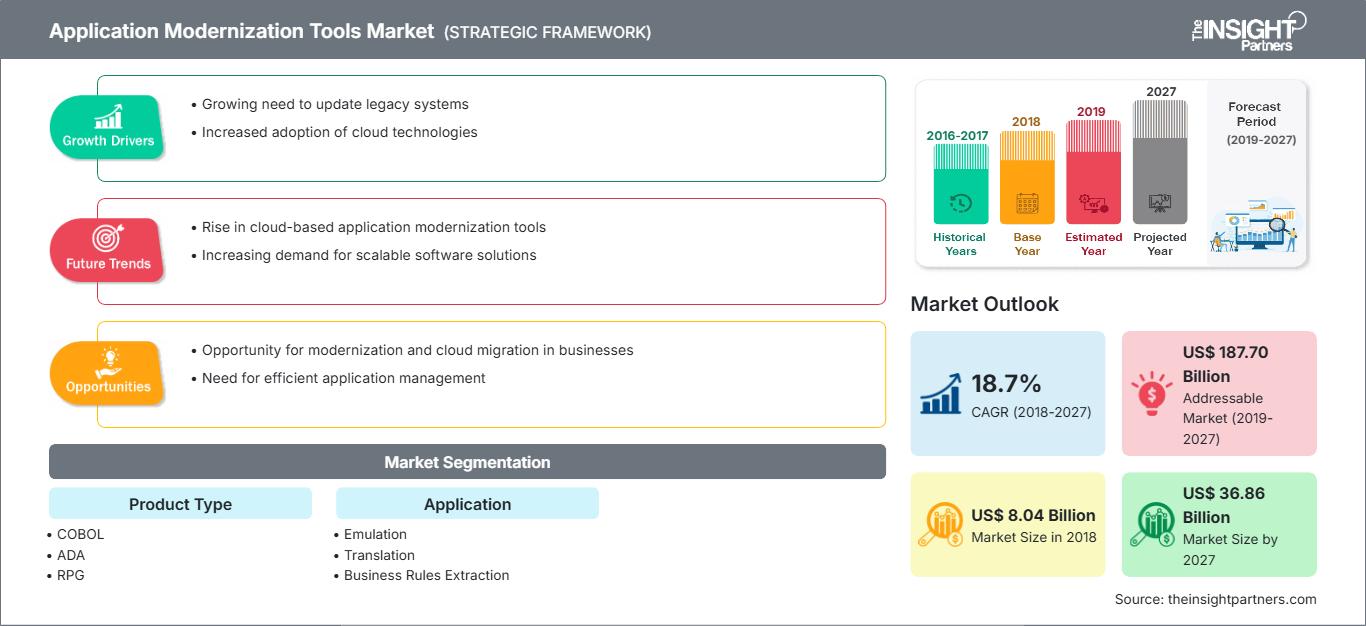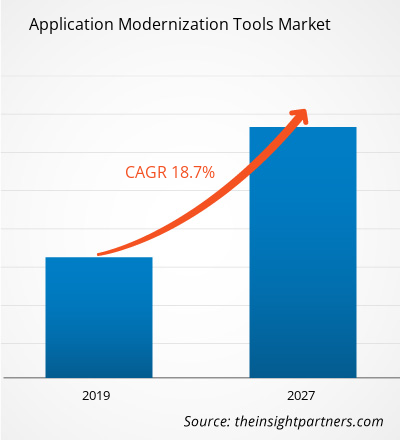El mercado global de herramientas de modernización de aplicaciones representó US$ 8,04 mil millones en 2018 y se espera que crezca a una CAGR del 18,7% durante el período de pronóstico 2019-2027, para alcanzar los US$ 36,86 mil millones en 2027.
Se prevé que América del Norte ostente la mayor cuota de mercado en herramientas de modernización de aplicaciones para 2027. Los gobiernos están maximizando sus inversiones digitales aprovechando estratégicamente las nuevas tecnologías, así como los datos y la analítica avanzada, para optimizar políticas y programas, y actualizar sus sistemas heredados. Mejorar y alinear procesos; atraer nuevos inversores; implementar un enfoque inteligente basado en datos en las operaciones gubernamentales; facilitar el acceso a la información y optimizar su gestión; aumentar la satisfacción y la confianza ciudadana; transformar los servicios de transacciones gubernamentales; y satisfacer las necesidades de una demografía en constante cambio, equilibrando los costes y optimizando la eficiencia, son factores clave en la continua transformación de las TI en los sectores gubernamental, público y privado.
Perspectivas del mercado
La creciente transformación digital en las industrias está impulsando la demanda del mercado de herramientas de modernización de aplicaciones.
La optimización integral de los procesos de negocio, el aumento de la eficiencia operativa, la mejora de la experiencia del cliente y la reducción de costes son algunos de los factores que impulsan el mercado de herramientas de modernización de aplicaciones. El cambio de paradigma de las empresas, de los canales tradicionales a los canales digitales y automatizados, genera múltiples beneficios, desde una mayor eficiencia hasta la reducción de costes y el aumento de las oportunidades de ingresos, impulsando así el crecimiento del mercado de herramientas de modernización de aplicaciones.
Obtendrá personalización en cualquier informe, sin cargo, incluidas partes de este informe o análisis a nivel de país, paquete de datos de Excel, así como también grandes ofertas y descuentos para empresas emergentes y universidades.
Mercado de herramientas de modernización de aplicaciones: perspectivas estratégicas

- Obtenga las principales tendencias clave del mercado de este informe.Esta muestra GRATUITA incluirá análisis de datos, desde tendencias del mercado hasta estimaciones y pronósticos.
El alto grado de integración con otras soluciones ofrece una oportunidad lucrativa para el mercado de herramientas de modernización de aplicaciones.
Los actores del mercado de herramientas de modernización de aplicaciones integran diversas soluciones con las aplicaciones y el front-end en tabletas, dispositivos móviles y la web. Es una forma rentable y rápida de implementar nuevos procesos de negocio en cualquier aplicación. Los proveedores de servicios integran soluciones como la automatización robótica de procesos (RPA), una plataforma de automatización como servicio. Esta permite replicar la interacción entre la tecnología y el ser humano para automatizar una amplia gama de operaciones y procesos de soporte de forma rentable y aumenta la fiabilidad.
Información sobre el tipo de producto
El mercado global de herramientas de modernización de aplicaciones, por tipo de producto, estuvo liderado por el segmento COBOL. El proceso de modernización de aplicaciones es bastante complejo con los métodos tradicionales, pero con la adopción de tecnologías ágiles, se ha simplificado y mejorado su precisión. COBOL es un lenguaje de programación de alto nivel que genera aplicaciones totalmente web y rediseña proyectos a tiempo, además de ejecutar estándares y seguir especificaciones para una mejor apariencia, gracias a la modernización de aplicaciones .NET y Java. Diversas plataformas disponibles en el mercado transforman el código existente en lenguajes avanzados.
Perspectivas de la aplicación
El mercado global de herramientas de modernización de aplicaciones, por aplicación, estuvo liderado por el segmento de emulación en 2018. Además, se espera que este segmento ocupe la mayor cuota de mercado en herramientas de modernización de aplicaciones para 2027. La emulación es un proceso para reubicar el enfoque de modernización utilizado para proporcionar un entorno que compila en plataformas distribuidas mediante la emulación del entorno operativo heredado. La capacidad de emulación reduce la cantidad de cambios que se producen al migrar el sistema heredado a una plataforma distribuida. El proceso de emulación ofrece la técnica más rápida para migrar cargas de trabajo desde un mainframe y una forma comparativamente económica y de bajo riesgo de reducir los costes operativos y mantener el valor comercial. Se espera que estos factores impulsen la demanda de aplicaciones de emulación en el mercado de herramientas de modernización de aplicaciones.
Perspectivas regionales del mercado de herramientas de modernización de aplicaciones
Los analistas de The Insight Partners han explicado detalladamente las tendencias regionales y los factores que influyen en el mercado de herramientas de modernización de aplicaciones durante el período de pronóstico. Esta sección también analiza los segmentos y la geografía del mercado de herramientas de modernización de aplicaciones en América del Norte, Europa, Asia Pacífico, Oriente Medio y África, y América del Sur y Central.
Alcance del informe de mercado de herramientas de modernización de aplicaciones
| Atributo del informe | Detalles |
|---|---|
| Tamaño del mercado en 2018 | US$ 8.04 mil millones |
| Tamaño del mercado en 2027 | US$ 36.86 mil millones |
| CAGR global (2018-2027) | 18,7% |
| Datos históricos | 2016-2017 |
| Período de pronóstico | 2019-2027 |
| Segmentos cubiertos | Por tipo de producto
|
| Regiones y países cubiertos | América del norte
|
| Líderes del mercado y perfiles de empresas clave |
|
Densidad de actores del mercado de herramientas de modernización de aplicaciones: comprensión de su impacto en la dinámica empresarial
El mercado de herramientas de modernización de aplicaciones está creciendo rápidamente, impulsado por la creciente demanda de los usuarios finales debido a factores como la evolución de las preferencias de los consumidores, los avances tecnológicos y una mayor comprensión de los beneficios del producto. A medida que aumenta la demanda, las empresas amplían su oferta, innovan para satisfacer las necesidades de los consumidores y aprovechan las tendencias emergentes, lo que impulsa aún más el crecimiento del mercado.

- Obtenga una descripción general de los principales actores clave del mercado de herramientas de modernización de aplicaciones
Los actores del mercado de herramientas de modernización de aplicaciones se centran principalmente en la mejora de sus productos mediante la implementación de tecnologías avanzadas. A continuación, se enumeran algunos de los desarrollos recientes:
- 2019: Atos anunció la mejora de la plataforma Atos Managed OpenShift (AMOS) con la ayuda de nuevas funciones de automatización integradas de la plataforma de automatización SyntBots. Esta actualización es fruto de la colaboración entre Atos y Red Hat.
- 2018: Micro Focus anunció la disponibilidad general de Visual Enterprise Suite 4.0 y COBOL 4.0, lo que marca un paso clave en la implementación de su visión de transformación digital para facilitar a los clientes la actualización de los principales procesos comerciales y la tecnología.
- 2017: Blu Age anunció su alianza con Advanced para ofrecer su solución revolucionaria: migración a COBOL y modernización de datos. Con esta alianza, la compañía ofrece su solución automatizada para transformar sus aplicaciones COBOL heredadas a Java y .NET.
Segmentación del mercado global de herramientas de modernización de aplicaciones
Por tipo de producto
- COBOL
- ADA
- Juego de rol
- Ensamblador
- PowerBuilder
- Otros
Por aplicación
- Emulación
- Traducción
- Extracción de reglas de negocio
Por geografía
- América del norte
- A NOSOTROS
- Canadá
- México
- Europa
- Francia
- Alemania
- Reino Unido
- Rusia
- Italia
- Resto de Europa
- Asia Pacífico (APAC)
- Australia
- Porcelana
- India
- Japón
- Corea del Sur
- Resto de APAC
- Oriente Medio y África (MEA)
- Arabia Saudita
- Sudáfrica
- Emiratos Árabes Unidos
- Resto de MEA
- América del Sur (SAM)
- Brasil
- Argentina
- Resto de SAM
Perfiles de empresas
- Grupo de software informático avanzado limitado
- Aspire Systems (India) Pvt. Ltd
- Asysco Software BV
- Atos SE
- Edad azul
- Deloitte Touche Tohmatsu Limited
- FreeSoft, Inc.
- Soluciones de portabilidad lingüística
- Micro Focus International plc
- Mphasis Limitada
- Diseños Semánticos, Incorporados
- Tecnologías de minería de software
- La Revolución del Software Inc. (TSRI)
- Corporación Virtusa
- Análisis histórico (2 años), año base, pronóstico (7 años) con CAGR
- Análisis PEST y FODA
- Tamaño del mercado, valor/volumen: global, regional y nacional
- Industria y panorama competitivo
- Conjunto de datos de Excel
Informes recientes
Testimonios
Razón para comprar
- Toma de decisiones informada
- Comprensión de la dinámica del mercado
- Análisis competitivo
- Información sobre clientes
- Pronósticos del mercado
- Mitigación de riesgos
- Planificación estratégica
- Justificación de la inversión
- Identificación de mercados emergentes
- Mejora de las estrategias de marketing
- Impulso de la eficiencia operativa
- Alineación con las tendencias regulatorias




















 Obtenga una muestra gratuita para - Mercado de herramientas de modernización de aplicaciones
Obtenga una muestra gratuita para - Mercado de herramientas de modernización de aplicaciones